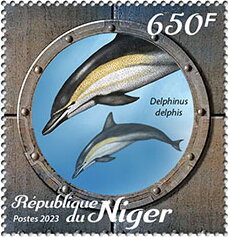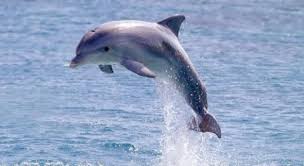Stamp: Delphinus delphis (Niger 2023)
Delphinus delphis (Niger 2023)
28 June (Niger ) within release Jules Verne (2023) goes into circulation Stamp Delphinus delphis face value 650 West African CFA franc
| Stamp Delphinus delphis in catalogues | |
|---|---|
| Yvert et Tellier: | Yt: NE 9083 |
Stamp is square format.
Also in the issue Jules Verne (2023):
- Mini Sheet - 195th Anniversary of the Birth of Jules Verne face value 6*650;
- Souvenir Sheet - Jules Verne (1828-1905) face value 3,600;
- Stamp - "Around the World in Eighty Days" face value 650;
- Stamp - Delphinus delphis face value 650;
- Stamp - Jules Verne (1828-1905) face value 650;
- Stamp - Jules Verne (1828-1905) face value 650;
- Stamp - Mount Fuji, Japan - Orcinus orca face value 650;
- Stamp - Stefan Drzewiecki's First Submarine, 1881 - Architeuthis dux face value 650;
Stamp Delphinus delphis it reflects the thematic directions:
An anniversary is the date on which an event took place or an institution was founded in a previous year, and may also refer to the commemoration or celebration of that event. For example, the first event is the initial occurrence or, if planned, the inaugural of the event. One year later would be the first anniversary of that event. The word was first used for Catholic feasts to commemorate saints. Most countries celebrate national anniversaries, typically called national days. These could be the date of independence of the nation or the adoption of a new constitution or form of government. The important dates in a sitting monarch's reign may also be commemorated, an event often referred to as a "Jubilee".
A dolphin is an aquatic mammal within the infraorder Cetacea. Dolphin species belong to the families Delphinidae (the oceanic dolphins), Platanistidae (the Indian river dolphins), Iniidae (the New World river dolphins), Pontoporiidae (the brackish dolphins), and possibly extinct Lipotidae (baiji or Chinese river dolphin). There are 40 extant species named as dolphins.
Marine mammals are mammals that rely on marine (saltwater) ecosystems for their existence. They include animals such as cetaceans (whales, dolphins and porpoises), pinnipeds (seals, sea lions and walruses), sirenians (manatees and dugongs), sea otters and polar bears. They are an informal group, unified only by their reliance on marine environments for feeding and survival.
Marine life, or sea life or ocean life, refers to the plants, animals and other organisms that live in the salt water of the sea or ocean, or the brackish water of coastal estuaries. At a fundamental level, marine life helps determine the very nature of our planet. Marine organisms produce much of the oxygen we breathe. Shorelines are in part shaped and protected by marine life, and some marine organisms even help create new land. Altogether there are 230,000 documented marine species, including over 16,000 species of fish, and it has been estimated that nearly two million marine species are yet to be documented. Marine species range in size from the microscopic, including plankton and phytoplankton which can be as small as 0.02 micrometres, to huge cetaceans (whales, dolphins and porpoises) which in the case of the blue whale reach up to 33 metres (109 feet) in length, being the largest known animal.




